Abstract
1. The effect of R75231, an inhibitor of purine nucleoside transport, were examined on ischaemic arrhythmias in anaesthetized pigs. 2. In closed chest pigs (n = 4), R75231 exerted a moderate dose-dependent decrease in mean arterial blood pressure (from 97 +/- 4 mmHg to 95 +/- 4, 90 +/- 1 and 83 +/- 2 mmHg at 25, 50 and 100 micrograms kg-1 respectively) and produced a dose-related shift to the left of the blood pressure dose-response curve to intravenous bolus doses of adenosine. The degree of inhibition of adenosine uptake by R75231, assessed ex vivo in erythrocyte suspensions, was 43 +/- 5%, 64 +/- 13 and 114 +/- 15% at doses of 25, 50 and 100 micrograms kg-1 respectively. 3. In open chest pigs, intravenous injection of R75231 (50 micrograms kg-1; n = 6 and 100 micrograms kg-1; n = 10) induced a dose-related decrease in both systolic and diastolic arterial blood pressure which was more marked than in closed-chest pigs (mean pressure 86 +/- 4 to 70 +/- 2 mmHg and 88 +/- 6 to 60 +/- 6 mmHg with 50 and 100 micrograms kg-1 respectively), without affecting heart rate or myocardial contractility. Coronary artery occlusion in these pigs caused a secondary decrease in blood pressure. This was not observed in controls (n = 10). The lower dose of R75231 did not exert any antifibrillatory effects, whereas the higher dose significantly reduced the incidence of ventricular fibrillation, from 80% in control pigs to 30%.(ABSTRACT TRUNCATED AT 250 WORDS)
Full text
PDF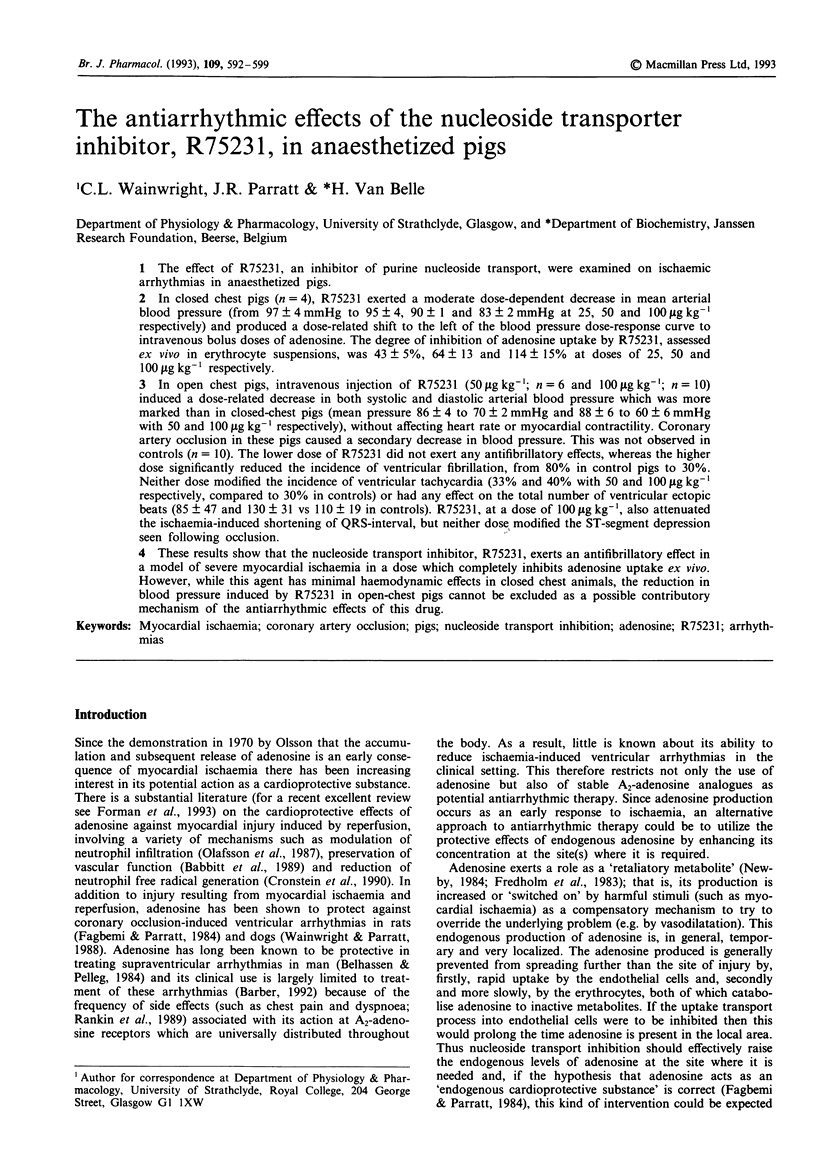
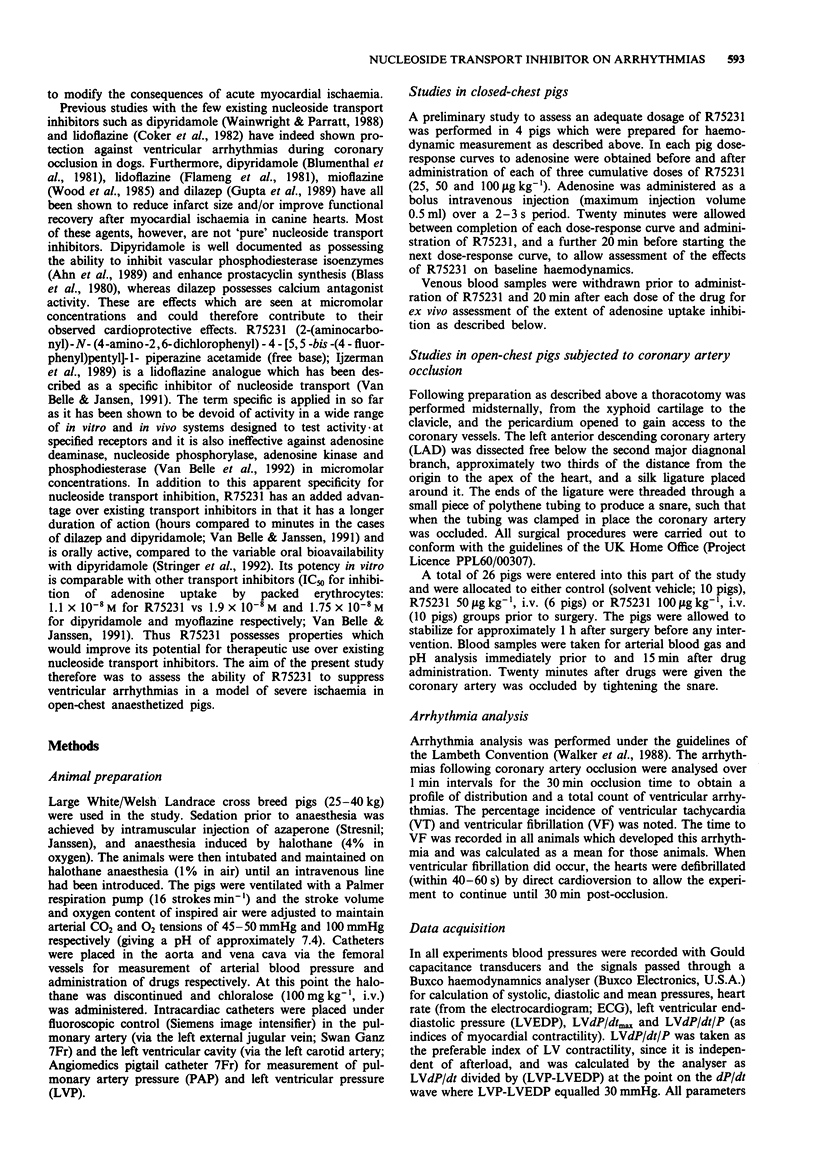
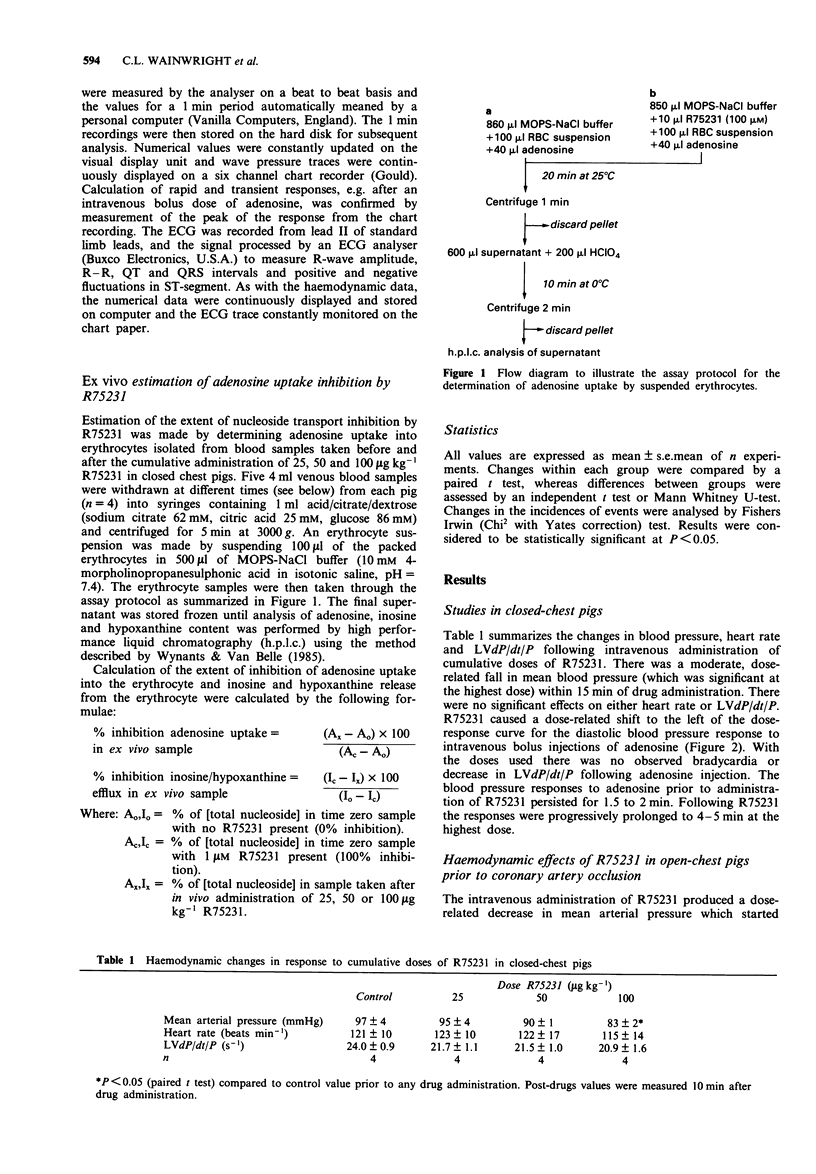
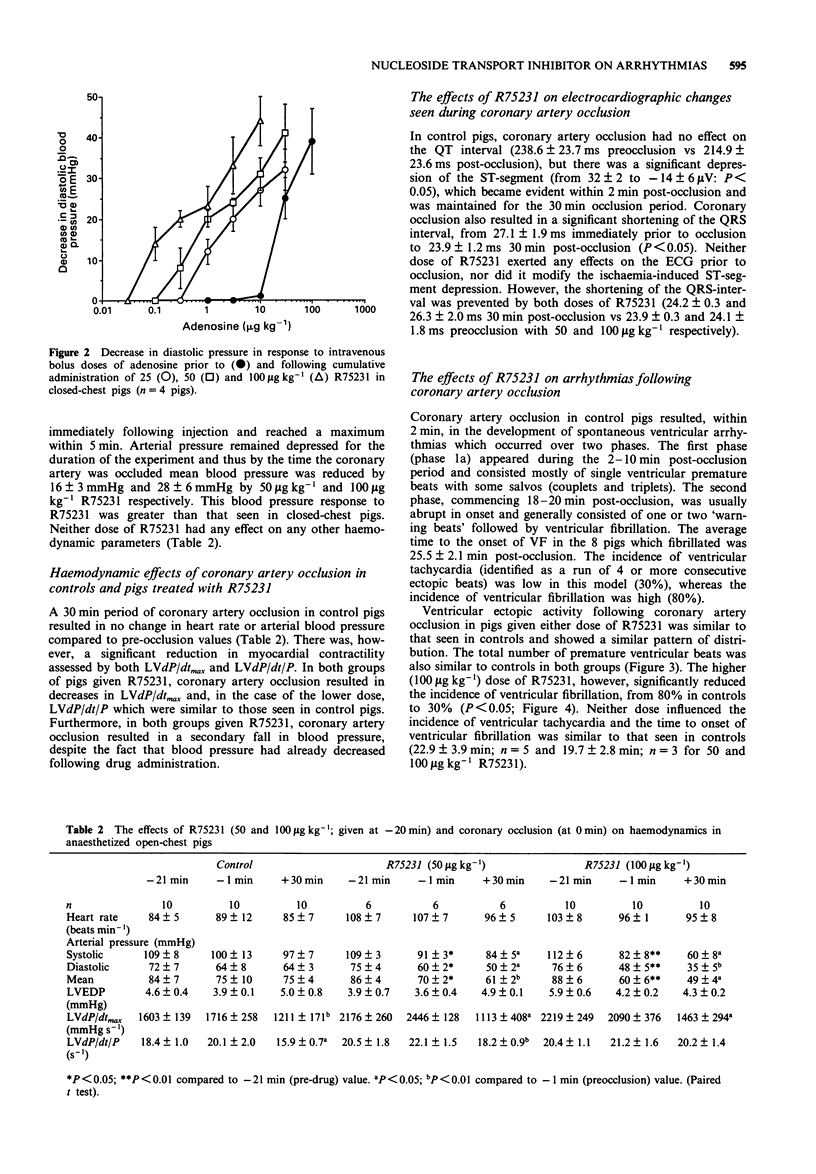
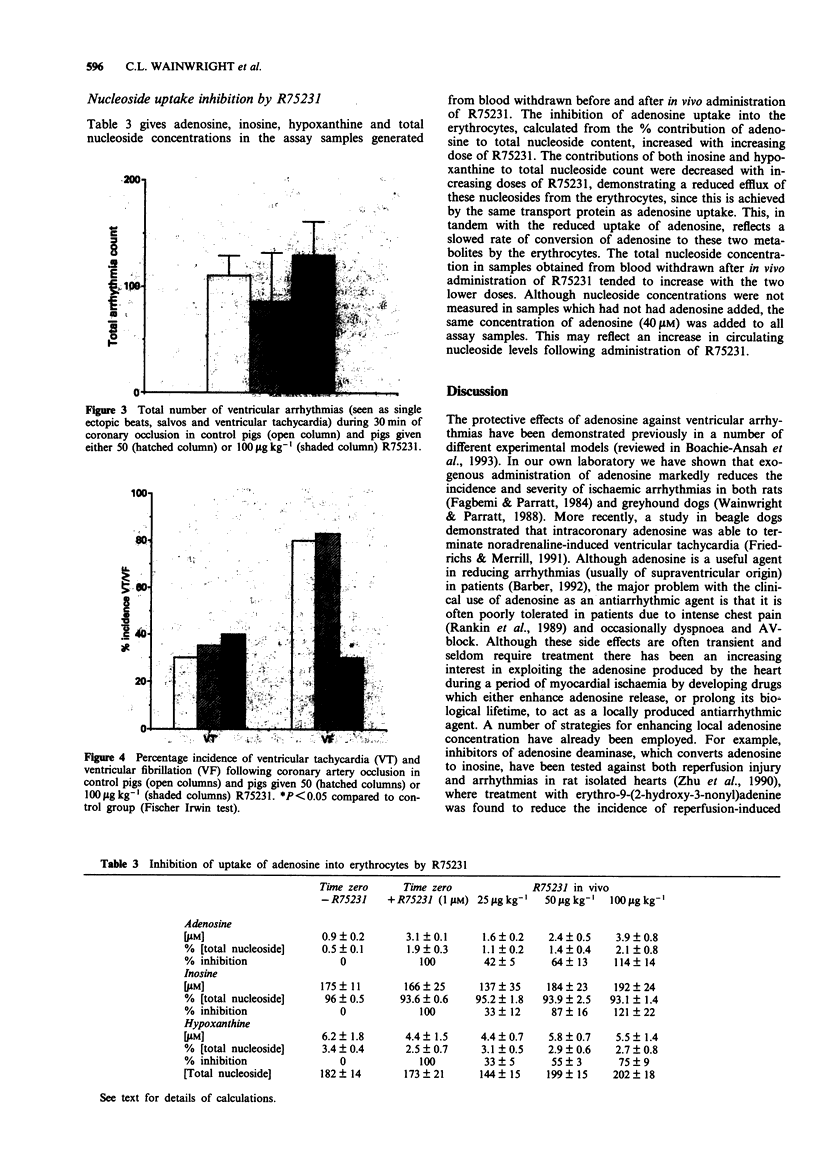
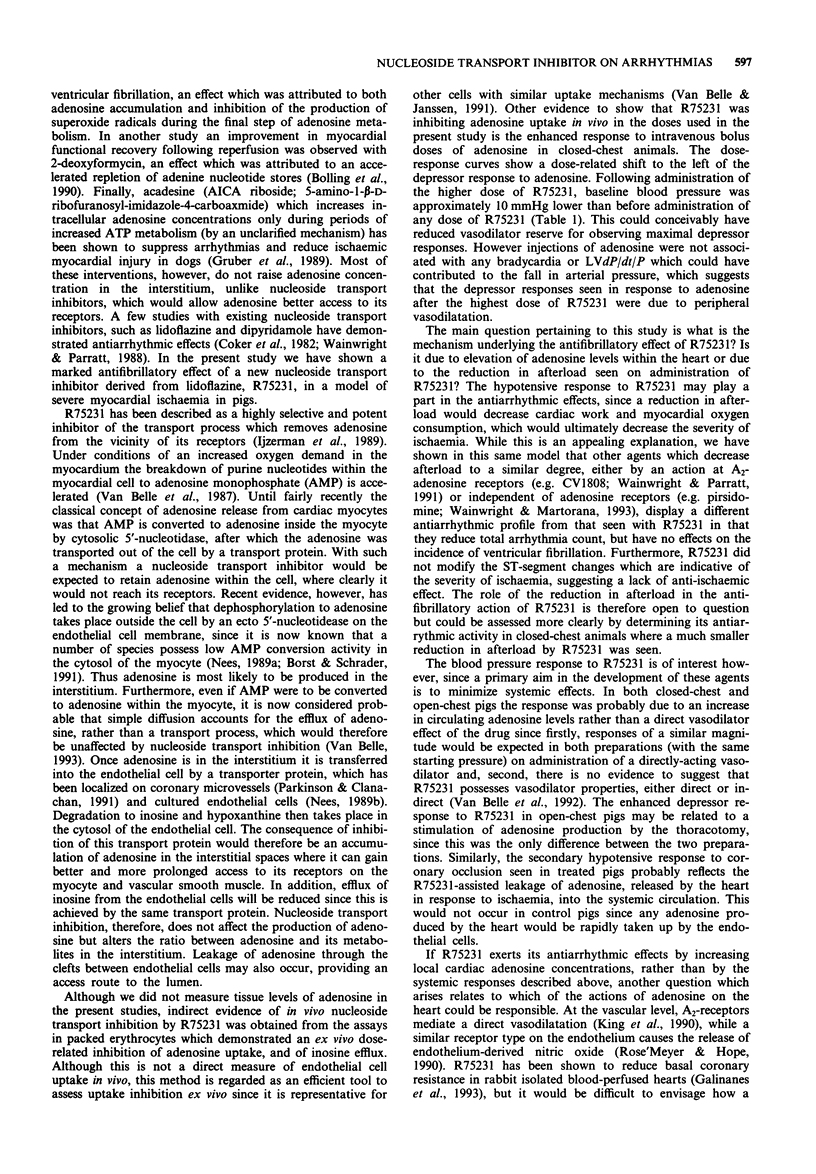
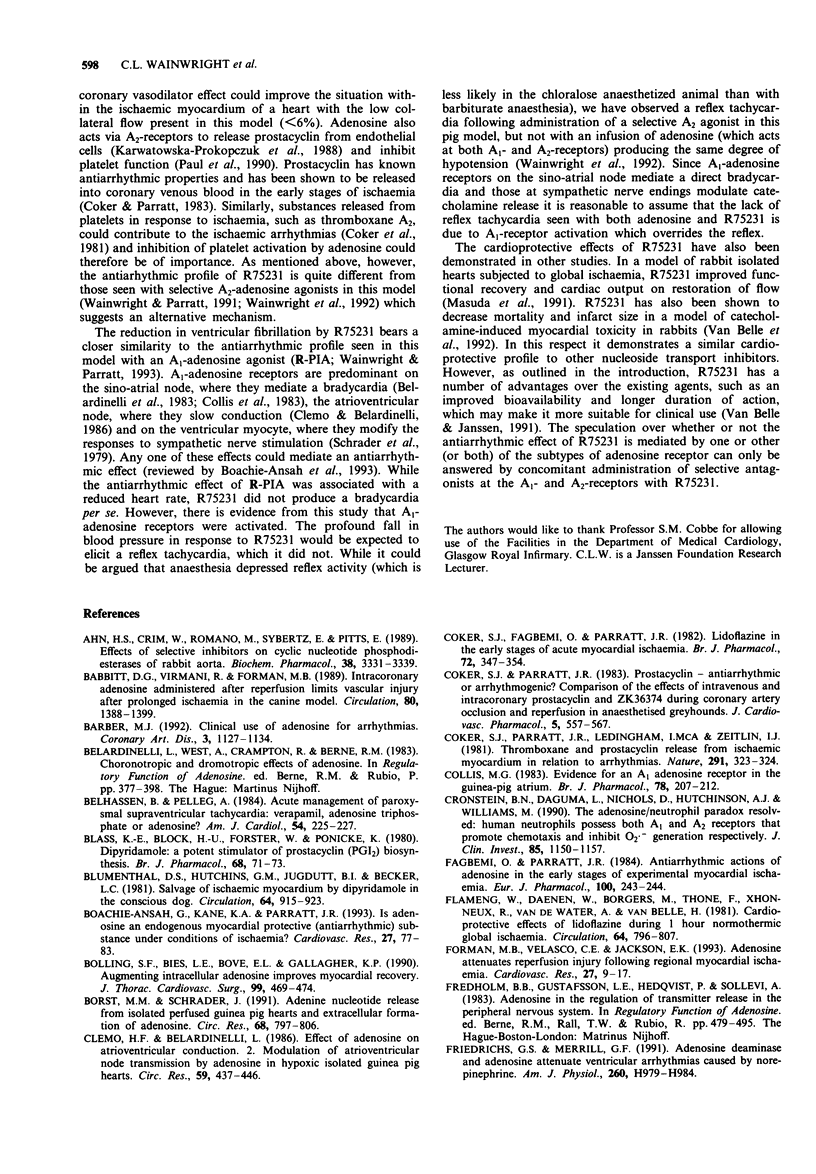
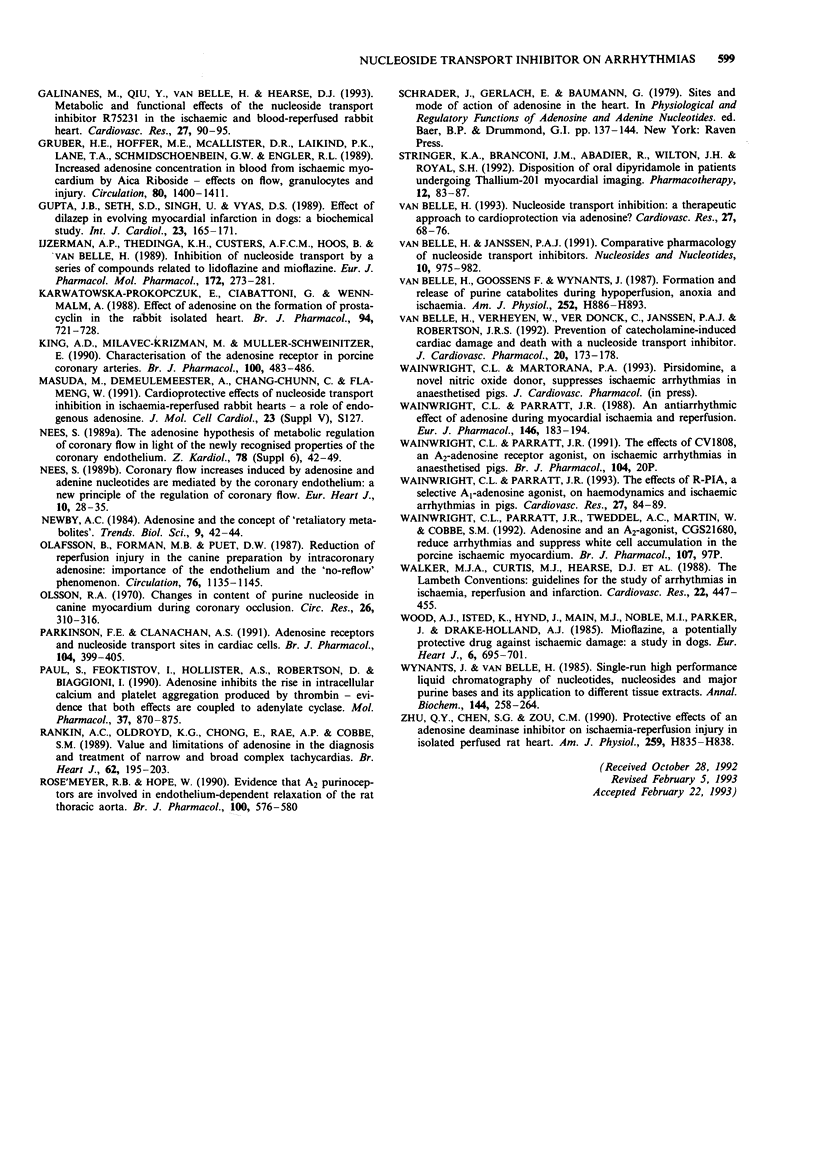
Selected References
These references are in PubMed. This may not be the complete list of references from this article.
- Ahn H. S., Crim W., Romano M., Sybertz E., Pitts B. Effects of selective inhibitors on cyclic nucleotide phosphodiesterases of rabbit aorta. Biochem Pharmacol. 1989 Oct 1;38(19):3331–3339. doi: 10.1016/0006-2952(89)90631-x. [DOI] [PubMed] [Google Scholar]
- Babbitt D. G., Virmani R., Forman M. B. Intracoronary adenosine administered after reperfusion limits vascular injury after prolonged ischemia in the canine model. Circulation. 1989 Nov;80(5):1388–1399. doi: 10.1161/01.cir.80.5.1388. [DOI] [PubMed] [Google Scholar]
- Belhassen B., Pelleg A. Acute management of paroxysmal supraventricular tachycardia: verapamil, adenosine triphosphate or adenosine? Am J Cardiol. 1984 Jul 1;54(1):225–227. doi: 10.1016/0002-9149(84)90334-5. [DOI] [PubMed] [Google Scholar]
- Blass K. E., Block H. U., Förster W., Pönicke K. Dipyridamole: a potent stimulator of prostacyclin (PGI2) biosynthesis. Br J Pharmacol. 1980 Jan;68(1):71–73. doi: 10.1111/j.1476-5381.1980.tb10700.x. [DOI] [PMC free article] [PubMed] [Google Scholar]
- Blumenthal D. S., Hutchins G. M., Jugdutt B. I., Becker L. C. Salvage of ischemic myocardium by dipyridamole in the conscious dog. Circulation. 1981 Nov;64(5):915–923. doi: 10.1161/01.cir.64.5.915. [DOI] [PubMed] [Google Scholar]
- Boachie-Ansah G., Kane K. A., Parratt J. R. Is adenosine an endogenous myocardial protective (antiarrhythmic) substance under conditions of ischaemia? Cardiovasc Res. 1993 Jan;27(1):77–83. doi: 10.1093/cvr/27.1.77. [DOI] [PubMed] [Google Scholar]
- Bolling S. F., Bies L. E., Bove E. L., Gallagher K. P. Augmenting intracellular adenosine improves myocardial recovery. J Thorac Cardiovasc Surg. 1990 Mar;99(3):469–474. [PubMed] [Google Scholar]
- Borst M. M., Schrader J. Adenine nucleotide release from isolated perfused guinea pig hearts and extracellular formation of adenosine. Circ Res. 1991 Mar;68(3):797–806. doi: 10.1161/01.res.68.3.797. [DOI] [PubMed] [Google Scholar]
- Clemo H. F., Belardinelli L. Effect of adenosine on atrioventricular conduction. II: Modulation of atrioventricular node transmission by adenosine in hypoxic isolated guinea pig hearts. Circ Res. 1986 Oct;59(4):437–446. doi: 10.1161/01.res.59.4.437. [DOI] [PubMed] [Google Scholar]
- Coker S. J., Fagbemi O., Parratt J. R. Lidoflazine in the early stages of acute myocardial ischaemia. Br J Pharmacol. 1982 Jun;76(2):347–354. doi: 10.1111/j.1476-5381.1982.tb09226.x. [DOI] [PMC free article] [PubMed] [Google Scholar]
- Coker S. J., Parratt J. R., Ledingham I. M., Zeitlin I. J. Thromboxane and prostacyclin release from ischaemic myocardium in relation to arrhythmias. Nature. 1981 May 28;291(5813):323–324. doi: 10.1038/291323a0. [DOI] [PubMed] [Google Scholar]
- Coker S. J., Parratt J. R. Prostacyclin--antiarrhythmic or arrhythmogenic? Comparison of the effects of intravenous and intracoronary prostacyclin and ZK36374 during coronary artery occlusion and reperfusion in anaesthetised greyhounds. J Cardiovasc Pharmacol. 1983 Jul-Aug;5(4):557–567. doi: 10.1097/00005344-198307000-00008. [DOI] [PubMed] [Google Scholar]
- Collis M. G. Evidence for an A1-adenosine receptor in the guinea-pig atrium. Br J Pharmacol. 1983 Jan;78(1):207–212. doi: 10.1111/j.1476-5381.1983.tb09381.x. [DOI] [PMC free article] [PubMed] [Google Scholar]
- Cronstein B. N., Daguma L., Nichols D., Hutchison A. J., Williams M. The adenosine/neutrophil paradox resolved: human neutrophils possess both A1 and A2 receptors that promote chemotaxis and inhibit O2 generation, respectively. J Clin Invest. 1990 Apr;85(4):1150–1157. doi: 10.1172/JCI114547. [DOI] [PMC free article] [PubMed] [Google Scholar]
- Fagbemi O., Parratt J. R. Antiarrhythmic actions of adenosine in the early stages of experimental myocardial ischaemia. Eur J Pharmacol. 1984 Apr 20;100(2):243–244. doi: 10.1016/0014-2999(84)90231-0. [DOI] [PubMed] [Google Scholar]
- Flameng W., Daenen W., Borgers M., Thone F., Xhonneux R., van de Water A., van Belle H. Cardioprotective effects of lidoflazine during 1-hour normothermic global ischemia. Circulation. 1981 Oct;64(4):796–807. doi: 10.1161/01.cir.64.4.796. [DOI] [PubMed] [Google Scholar]
- Forman M. B., Velasco C. E., Jackson E. K. Adenosine attenuates reperfusion injury following regional myocardial ischaemia. Cardiovasc Res. 1993 Jan;27(1):9–17. doi: 10.1093/cvr/27.1.9. [DOI] [PubMed] [Google Scholar]
- Friedrichs G. S., Merrill G. F. Adenosine deaminase and adenosine attenuate ventricular arrhythmias caused by norepinephrine. Am J Physiol. 1991 Mar;260(3 Pt 2):H979–H984. doi: 10.1152/ajpheart.1991.260.3.H979. [DOI] [PubMed] [Google Scholar]
- Galiñanes M., Qiu Y., Van Belle H., Hearse D. J. Metabolic and functional effects of the nucleoside transport inhibitor R75231 in the ischaemic and blood reperfused rabbit heart. Cardiovasc Res. 1993 Jan;27(1):90–95. doi: 10.1093/cvr/27.1.90. [DOI] [PubMed] [Google Scholar]
- Gruber H. E., Hoffer M. E., McAllister D. R., Laikind P. K., Lane T. A., Schmid-Schoenbein G. W., Engler R. L. Increased adenosine concentration in blood from ischemic myocardium by AICA riboside. Effects on flow, granulocytes, and injury. Circulation. 1989 Nov;80(5):1400–1411. doi: 10.1161/01.cir.80.5.1400. [DOI] [PubMed] [Google Scholar]
- Gupta J. B., Seth S. D., Singh U., Vyas D. S. Effects of dilazep in evolving myocardial infarction in dogs: a biochemical study. Int J Cardiol. 1989 May;23(2):165–171. doi: 10.1016/0167-5273(89)90244-1. [DOI] [PubMed] [Google Scholar]
- Ijzerman A. P., Thedinga K. H., Custers A. F., Hoos B., Van Belle H. Inhibition of nucleoside transport by a new series of compounds related to lidoflazine and mioflazine. Eur J Pharmacol. 1989 Aug 15;172(3):273–281. doi: 10.1016/0922-4106(89)90057-6. [DOI] [PubMed] [Google Scholar]
- Karwatowska-Prokopczuk E., Ciabattoni G., Wennmalm A. Effect of adenosine on the formation of prostacyclin in the rabbit isolated heart. Br J Pharmacol. 1988 Jul;94(3):721–728. doi: 10.1111/j.1476-5381.1988.tb11581.x. [DOI] [PMC free article] [PubMed] [Google Scholar]
- King A. D., Milavec-Krizman M., Müller-Schweinitzer E. Characterization of the adenosine receptor in porcine coronary arteries. Br J Pharmacol. 1990 Jul;100(3):483–486. doi: 10.1111/j.1476-5381.1990.tb15833.x. [DOI] [PMC free article] [PubMed] [Google Scholar]
- Nees S. Coronary flow increases induced by adenosine and adenine nucleotides are mediated by the coronary endothelium: a new principle of the regulation of coronary flow. Eur Heart J. 1989 Nov;10 (Suppl F):28–35. doi: 10.1093/eurheartj/10.suppl_f.28. [DOI] [PubMed] [Google Scholar]
- Nees S. The adenosine hypothesis of metabolic regulation of coronary flow in the light of newly recognized properties of the coronary endothelium. Z Kardiol. 1989;78 (Suppl 6):42–49. [PubMed] [Google Scholar]
- Olafsson B., Forman M. B., Puett D. W., Pou A., Cates C. U., Friesinger G. C., Virmani R. Reduction of reperfusion injury in the canine preparation by intracoronary adenosine: importance of the endothelium and the no-reflow phenomenon. Circulation. 1987 Nov;76(5):1135–1145. doi: 10.1161/01.cir.76.5.1135. [DOI] [PubMed] [Google Scholar]
- Parkinson F. E., Clanachan A. S. Adenosine receptors and nucleoside transport sites in cardiac cells. Br J Pharmacol. 1991 Oct;104(2):399–405. doi: 10.1111/j.1476-5381.1991.tb12442.x. [DOI] [PMC free article] [PubMed] [Google Scholar]
- Paul S., Feoktistov I., Hollister A. S., Robertson D., Biaggioni I. Adenosine inhibits the rise in intracellular calcium and platelet aggregation produced by thrombin: evidence that both effects are coupled to adenylate cyclase. Mol Pharmacol. 1990 Jun;37(6):870–875. [PubMed] [Google Scholar]
- Rankin A. C., Oldroyd K. G., Chong E., Rae A. P., Cobbe S. M. Value and limitations of adenosine in the diagnosis and treatment of narrow and broad complex tachycardias. Br Heart J. 1989 Sep;62(3):195–203. doi: 10.1136/hrt.62.3.195. [DOI] [PMC free article] [PubMed] [Google Scholar]
- Rose'Meyer R. B., Hope W. Evidence that A2 purinoceptors are involved in endothelium-dependent relaxation of the rat thoracic aorta. Br J Pharmacol. 1990 Jul;100(3):576–580. doi: 10.1111/j.1476-5381.1990.tb15849.x. [DOI] [PMC free article] [PubMed] [Google Scholar]
- Stringer K. A., Branconi J. M., Abadier R., Wilton J. H., Royal S. H. Disposition of oral dipyridamole in patients undergoing thallium 201 myocardial imaging. Pharmacotherapy. 1992;12(2):83–87. [PubMed] [Google Scholar]
- Van Belle H., Goossens F., Wynants J. Formation and release of purine catabolites during hypoperfusion, anoxia, and ischemia. Am J Physiol. 1987 May;252(5 Pt 2):H886–H893. doi: 10.1152/ajpheart.1987.252.5.H886. [DOI] [PubMed] [Google Scholar]
- Van Belle H. Nucleoside transport inhibition: a therapeutic approach to cardioprotection via adenosine? Cardiovasc Res. 1993 Jan;27(1):68–76. doi: 10.1093/cvr/27.1.68. [DOI] [PubMed] [Google Scholar]
- Van Belle H., Verheyen W., Ver Donck K., Janssen P. A., Robertson J. I. Prevention of catecholamine-induced cardiac damage and death with a nucleoside transport inhibitor. J Cardiovasc Pharmacol. 1992 Aug;20(2):173–178. doi: 10.1097/00005344-199208000-00001. [DOI] [PubMed] [Google Scholar]
- Wainwright C. L., Parratt J. R. An antiarrhythmic effect of adenosine during myocardial ischaemia and reperfusion. Eur J Pharmacol. 1988 Jan 12;145(2):183–194. doi: 10.1016/0014-2999(88)90229-4. [DOI] [PubMed] [Google Scholar]
- Wainwright C. L., Parratt J. R. Effects of R-PIA, a selective A1 adenosine agonist, on haemodynamics and ischaemic arrhythmias in pigs. Cardiovasc Res. 1993 Jan;27(1):84–89. doi: 10.1093/cvr/27.1.84. [DOI] [PubMed] [Google Scholar]
- Walker M. J., Curtis M. J., Hearse D. J., Campbell R. W., Janse M. J., Yellon D. M., Cobbe S. M., Coker S. J., Harness J. B., Harron D. W. The Lambeth Conventions: guidelines for the study of arrhythmias in ischaemia infarction, and reperfusion. Cardiovasc Res. 1988 Jul;22(7):447–455. doi: 10.1093/cvr/22.7.447. [DOI] [PubMed] [Google Scholar]
- Wood A. J., Isted K., Hynd J., Main M. J., Noble M. I., Parker J., Drake-Holland A. J. Mioflazine, a potentially protective drug against ischaemic damage: a study in dogs. Eur Heart J. 1985 Aug;6(8):695–701. doi: 10.1093/oxfordjournals.eurheartj.a061922. [DOI] [PubMed] [Google Scholar]
- Wynants J., Van Belle H. Single-run high-performance liquid chromatography of nucleotides, nucleosides, and major purine bases and its application to different tissue extracts. Anal Biochem. 1985 Jan;144(1):258–266. doi: 10.1016/0003-2697(85)90114-9. [DOI] [PubMed] [Google Scholar]
- Zhu Q. Y., Chen S. G., Zou C. M. Protective effects of an adenosine deaminase inhibitor on ischemia-reperfusion injury in isolated perfused rat heart. Am J Physiol. 1990 Sep;259(3 Pt 2):H835–H838. doi: 10.1152/ajpheart.1990.259.3.H835. [DOI] [PubMed] [Google Scholar]


